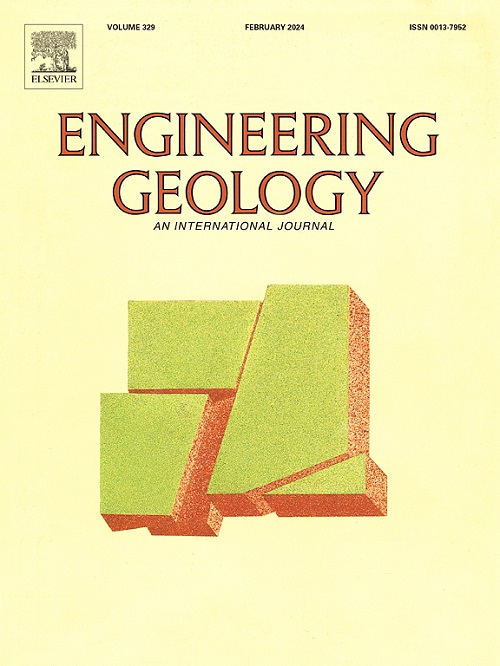Enhanced erosion resistance of granite residual soil through synergistic application of calcium lignosulfonate and microbial treatment
IF 6.9
1区 工程技术
Q1 ENGINEERING, GEOLOGICAL
引用次数: 0
Abstract
MICP technology has been increasingly applied in geotechnical improvement, but its effectiveness in enhancing the erosion resistance of granite residual soil embankment slopes remains limited. This study proposes a novel approach combining CLS with MICP to enhance the erosion resistance of the soil. The effects of CLS on MICP-treated granite residual soil were evaluated through physical-mechanical tests, microstructural analysis, and artificial rainfall experiments. The results indicate that CLS significantly improved the physical and mechanical properties of the soil, increasing the maximum dry density from 1.72 g/cm3 to 1.83 g/cm3, unconfined compressive strength by 184.15 %, and surface penetration resistance by 43.91 %. The CLS-MICP combination enhanced erosion resistance, reducing erosion by 65.9 % under high rainfall intensity. Microstructural analysis revealed that CLS optimized the pore structure of the soil, optimizing the soil's pore structure, and reducing the median pore throat radius from 0.37 μm to 0.18 μm. Mechanistic analysis demonstrated that CLS enhanced the cementation strength and stability of the soil under rainfall erosion by promoting uniform CaCO₃ precipitation and reducing porosity. These findings provide both theoretical and technical support for the application of CLS-MICP technology in improving granite residual soil.
木质素磺酸钙与微生物协同作用增强花岗岩残积土抗侵蚀能力
MICP技术在岩土工程改造中的应用越来越广泛,但其在提高花岗岩残积土路堤边坡抗侵蚀能力方面的效果仍然有限。本研究提出了一种将CLS与MICP相结合来增强土壤抗侵蚀能力的新方法。通过物理力学试验、微观结构分析和人工降雨试验,评价CLS对micp处理的花岗岩残积土的影响。结果表明,CLS显著改善了土体的物理力学性能,最大干密度由1.72 g/cm3提高到1.83 g/cm3,无侧限抗压强度提高184.15%,表面抗渗透能力提高43.91%。CLS-MICP组合增强了抗侵蚀能力,在强降雨条件下可减少65.9%的侵蚀。微观结构分析表明,CLS优化了土壤的孔隙结构,优化了土壤的孔隙结构,将中位孔喉半径从0.37 μm减小到0.18 μm。机理分析表明,CLS通过促进CaCO₃均匀降水和降低孔隙度来提高降雨侵蚀下土壤的胶结强度和稳定性。这些研究结果为CLS-MICP技术在花岗岩残积土改良中的应用提供了理论和技术支持。
本文章由计算机程序翻译,如有差异,请以英文原文为准。
求助全文
约1分钟内获得全文
求助全文
来源期刊

Engineering Geology
地学-地球科学综合
CiteScore
13.70
自引率
12.20%
发文量
327
审稿时长
5.6 months
期刊介绍:
Engineering Geology, an international interdisciplinary journal, serves as a bridge between earth sciences and engineering, focusing on geological and geotechnical engineering. It welcomes studies with relevance to engineering, environmental concerns, and safety, catering to engineering geologists with backgrounds in geology or civil/mining engineering. Topics include applied geomorphology, structural geology, geophysics, geochemistry, environmental geology, hydrogeology, land use planning, natural hazards, remote sensing, soil and rock mechanics, and applied geotechnical engineering. The journal provides a platform for research at the intersection of geology and engineering disciplines.
 求助内容:
求助内容: 应助结果提醒方式:
应助结果提醒方式:


